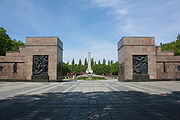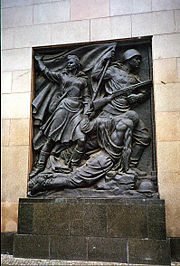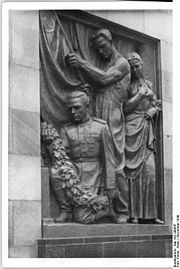
Soviet War Memorial (Schönholzer Heide)
Encyclopedia



Pankow
Pankow is the third borough of Berlin. In Berlin's 2001 administrative reform it was merged with the former boroughs of Prenzlauer Berg and Weißensee; the resulting borough retained the name Pankow.- Overview :...
, Berlin
Berlin
Berlin is the capital city of Germany and is one of the 16 states of Germany. With a population of 3.45 million people, Berlin is Germany's largest city. It is the second most populous city proper and the seventh most populous urban area in the European Union...
was erected in the period between May 1947 and November 1949 and covers an area of 30 000 m².
Schönholzer Heide was in the 19th century a popular recreation area. During the Second World War
World War II
World War II, or the Second World War , was a global conflict lasting from 1939 to 1945, involving most of the world's nations—including all of the great powers—eventually forming two opposing military alliances: the Allies and the Axis...
the place was turned into a work camp. After the war the north-western part of the area was used to build the third largest Soviet war memorial in Berlin, together with the memorials in Treptower Park
Soviet War Memorial (Treptower Park)
The Soviet War Memorial, is a vast war memorial and military cemetery in Berlin's Treptower Park. It was built to the design of the Soviet architect Yakov Belopolsky to commemorate 5,000 of the 80,000 Soviet soldiers who fell in the Battle of Berlin in April–May 1945...
and Tiergarten.
Soviet War Memorial (Tiergarten)
The Soviet War Memorial is one of several war memorials in Berlin, capital city of Germany, erected by the Soviet Union to commemorate its war dead, particularly the 80,000 soldiers of the Soviet Armed Forces who died during the Battle of Berlin in April and May 1945.The memorial is located in the...
A group of Soviet architects consisting of A. Solowjew, M. Belarnzew, W. D. Koroljew and the sculptor Iwan G. Perschudtschew made the sketch for the cemetery, where 13,200 of the 80,000 Soviet soldiers that had fallen during the battle of Berlin
Battle of Berlin
The Battle of Berlin, designated the Berlin Strategic Offensive Operation by the Soviet Union, was the final major offensive of the European Theatre of World War II....
, should be buried. On a wall around the memorial there are 100 bronze tablets where the names, ranks and birth dates of the soldiers it was possible to identify, are written. This group constitutes about one fifth of the fallen soldiers.
On both side of the main axis, which at its end one finds a 33,5 meter tall obelisk made of syenite
Syenite
Syenite is a coarse-grained intrusive igneous rock of the same general composition as granite but with the quartz either absent or present in relatively small amounts Syenite is a coarse-grained intrusive igneous rock of the same general composition as granite but with the quartz either absent or...
, there are placed 8 burial chambers where 1182 soldiers are buried. Under the Honor Hall inside the obelisk
Obelisk
An obelisk is a tall, four-sided, narrow tapering monument which ends in a pyramid-like shape at the top, and is said to resemble a petrified ray of the sun-disk. A pair of obelisks usually stood in front of a pylon...
there are buried two Soviet colonel
Colonel
Colonel , abbreviated Col or COL, is a military rank of a senior commissioned officer. It or a corresponding rank exists in most armies and in many air forces; the naval equivalent rank is generally "Captain". It is also used in some police forces and other paramilitary rank structures...
s.
A statue of the Russian Mother Earth is situated in front of the obelisk and constitutes the main point of the memorial. On the statue's base, which is made out of black porphyry
Porphyry (geology)
Porphyry is a variety of igneous rock consisting of large-grained crystals, such as feldspar or quartz, dispersed in a fine-grained feldspathic matrix or groundmass. The larger crystals are called phenocrysts...
, one finds 42 bronze tablets on which the names of fallen officers are inscribed.

